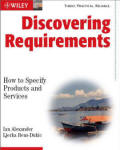
Snippets

Perhaps your first thought about requirements work is that it is simple: you just write down what you need.
Perhaps your experience of trying to write down what you need is that it is not easy: you did not get what you wanted.
“Simple but not easy”: why is that? Things that look simple but are not easy include many traditional skills and crafts.

Ian was lucky enough on a trip to Indonesia some years ago to be able to watch some traditional boatbuilders at work. They had no workshop other than the beach, and no tools other than hand-adzes, hand-drills, and wooden mallets. They used nothing except wood, with moss to fill in the gaps between planks. How did they make the planks fit? How did they know what shape to make each plank? How did they select the wood? They tapped and scraped, a little at a time. They put wooden dowel pegs in the holes in the plank they had just fitted. Then, they carefully lined up the holes in the newly-shaped plank over the dowels, and gently tapped the plank into place until it was snug and watertight. Each operation was beautifully simple. The final result was a strong, seaworthy boat, like the one in the photograph above.

A tram service offers to provide fast, safe, and reliable travel for passengers (and their shopping) around a town. It does that at the price of a considerable investment in infrastructure. That includes the trams themselves, street redesign (see the photograph above), track, tram-stops, information systems, ticketing, maintenance depots, and so on.
Introducing a tram causes side-effects. One likely effect is disruption to other modes of transport. Car drivers may find sharing a road with a tram difficult. They may not be allowed to drive on the tram tracks. Some roads will be made one-way. It may be difficult to cross the tram route. The remaining routes may become congested by queues of cars.
Trams can have complex effects on people and businesses, both positive and negative. People can travel further and faster on some routes, using the tram. But they can take people away from businesses as easily as bring people in. A tram stop in front of a shop or a hotel could bring more customers by tram, or it might put off customers who like to arrive by car.
Each stakeholder has a different set of goals for the tram service.


A workshop is a kind of performance. Many people will attend, so each minute of workshop time costs many minutes of salaried time. Each participant wants to benefit from the time invested. Each participant will make a judgement on whether your workshop – and you – were worth their time.
It is therefore better to rehearse your plan in ordinary ‘slow’ time, and to discover your mistakes in private, rather than to make costly mistakes in workshop time.
Workshops are like theatre, too, in that people want to enjoy the time, as well as to get results. Getting stakeholders’ “buy-in” is often critical to success. An element of showmanship is necessary. That means planning, rehearsal, and playing the role.
Direct use of Improvisational Theatre (“Improv”) techniques is also possible (scenarios, role-plays...); or, Improv can be used as a training aid for better team-based innovation performances. Simple techniques such as acting a scenario around a flipchart model of a user interface can be very effective.
(c) Ian Alexander 2009